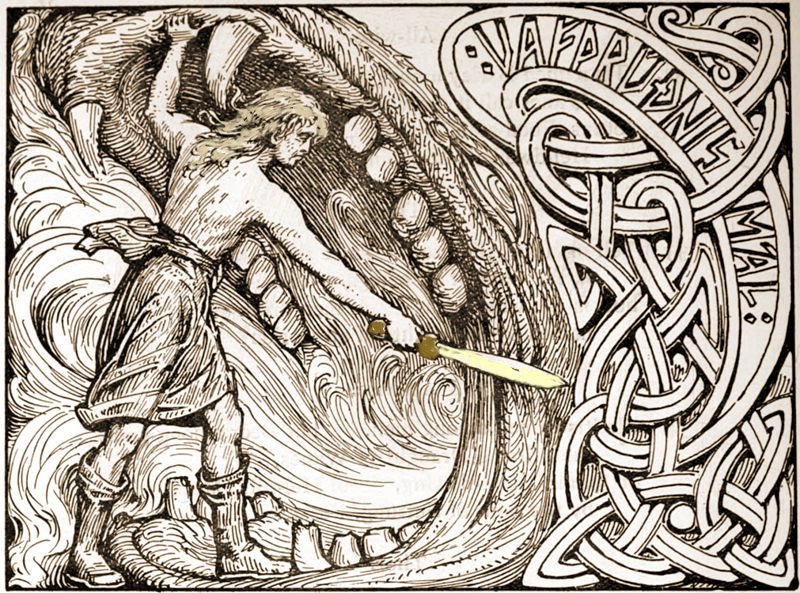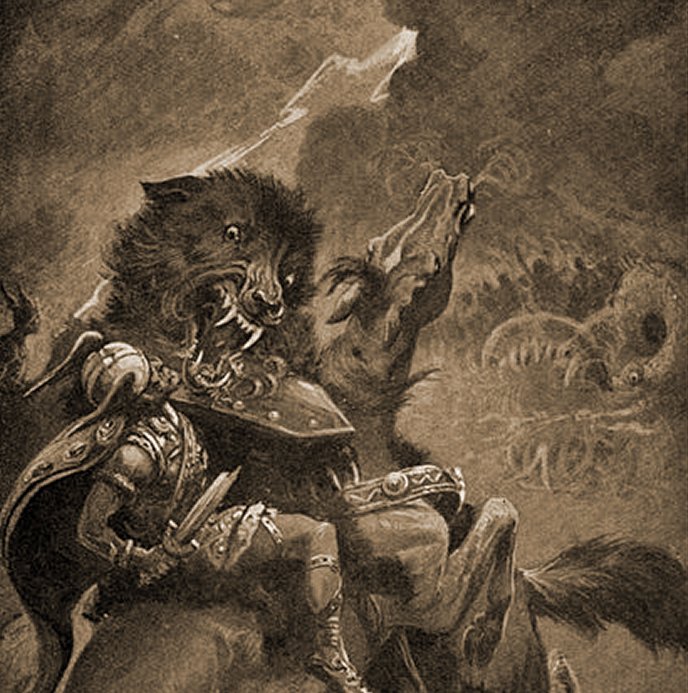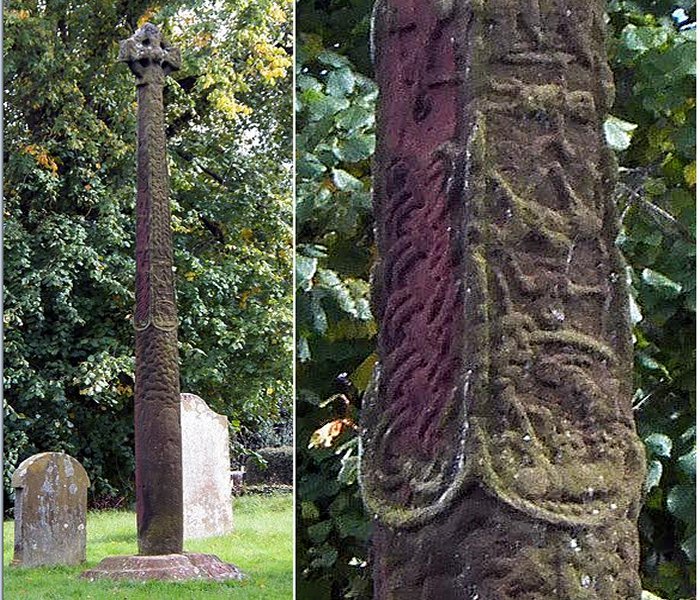Fenrir Killed At Ragnarok By Vidar Who Avenged His Father Odin’s Death
A. Sutherland - AncientPages.com - In Norse mythology, Vidar (in Old Norse: Vidarr – “wide ruler”) was famous for his silence.
He was one of the respected gods among the Aesir and one of the two gods associated with vengeance (the other was Vali, his half-brother). Vidar was also a very brave and fierce warrior who did not like to speak much and boast.
The god Víðarr stands in the jaws of Fenrir and swings his sword. The list of illustrations in the book's front matter gives this one the title Vidar (motive from the Gosforth Cross). Credit: W.G. Collingwood (1854 - 1932) – Public Domain
He possessed an enormous strength, which was only surpassed by Thor, and the Aesir gods often depended on him in times of trouble.
Vidar – “the silent god,” is foretold to avenge his father's death by killing the wolf Fenrir at Ragnarok. This god is attested in several sources, like Snorri Sturluson "Edda" and his "Prose Edda" books Gylfaginning and Skáldskaparmál. He is also mentioned in the Poetic Edda, the Icelandic medieval manuscript known as the Codex Regius. The Codex Regius is considered the most important source of Norse mythology and Germanic heroic legends.
In our earlier article, we were acquainted with the evil Fenrir (“bog dweller”), who had to feed on the bodies of the dead. Born in the Iron Forest (Járnviðr , Järnwidur), located on the border of Utgard and Midgard, Fenrir (or Fenris) was one of three terrible monster children of the trickster god Loki. He was born in the likeness of a gigantic wolf whose eyes and nostrils spewed out a fire.
His mother was the giantess and witch, Angrboda, who had two other terrible children, Hel, ruler of Niflheim, the land of the dead, and the Midgard Serpent, Jormungand, a hideous, venom-spewing serpent
These two – not exactly friendly creatures - were siblings of Fenrir.
Fenrir, the monster-wolf, and the god Odin in a fight. Image credit: Dorothy Hardy (fl. 1891 - 1925) via Wikipedia
Vidar’s father was the great god Odin, and his mother, the friendly giantess Grid. His home was called Vidi (Vide or Landvidi), a peaceful and silent place full of tall grasses, growing saplings, and wildflowers, where he rides and exercises his spear.
In the saga Grímnismál, Odin describes the halls of many gods, including that of his son Vidar:
“…Brushwood grows and high grass
widely in Vidar's land
and there the son proclaims on his horse's back
that he's keen to avenge his father..”.
Hero Vidar Depicted On Stone Cross
God Vidar was so admired that in the 9th century, he was depicted on a stone cross in the English city of Gosforth in Cumbria, England. On the cross, he fights against Fenrir, the wolf, immediately after he devoured his father Odin.
Gosforth cross; the tallest Viking cross in England. In the graveyard of the parish church of Gosforth, Cumbria. Image credit; Doug Sim/Wikipedia
The Gosforth Cross has intricate carvings depicting characters and scenes from Norse mythology. These include the god Heimdallr holding his horn; the god Vidar tearing the jaws of the wolf Fenrir; Thor's failed attempt to catch Jormungand, the Midgard Serpent, and Loki, the trickster god.
Deadly Encounter With Fenrir
One day in the future, the god Vidar must leave his quiet and peaceful land to fight at Ragnarok, “the darkness of the gods”, the coming destruction of the world, whose inevitability is impossible to fight with.
He had to face the evil monster, Fenrir, and defeat him, so it happened.
That day, Vidar leaped from his horse and attacked Fenrir to avenge his father, Odin. He stepped down with one foot on the lower jaw of Fenrir, grabbing his upper jaw in one hand and tearing his mouth apart. Finally, Fenrir was dead.
Tradition has it that Vidar wore a special shoe or boot that had been made from leather pieces he saved throughout all time.
Another version of the myth says that it was Vidar's mother, Grid made the shoe for Vidar.
Vidar, “the silent god,” was one of the few gods who survived Ragnarok and became one of the rulers of the new world.
Updated on March 1, 2023
Written by – A. Sutherland - AncientPages.com Senior Staff Writer
Copyright © AncientPages.com All rights reserved. This material may not be published, broadcast, rewritten or redistributed in whole or part without the express written permission of AncientPages.com
More From Ancient Pages
-
 10 Remarkable Advanced Ancient Technologies Ahead Of Their Times
Ancient Technology | Jul 23, 2019
10 Remarkable Advanced Ancient Technologies Ahead Of Their Times
Ancient Technology | Jul 23, 2019 -
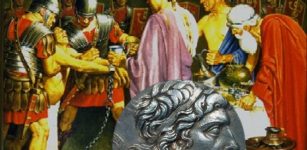 King Mithradates VI Of Pontus Used Poison To Avoid Death By Poison
Ancient History Facts | Mar 5, 2016
King Mithradates VI Of Pontus Used Poison To Avoid Death By Poison
Ancient History Facts | Mar 5, 2016 -
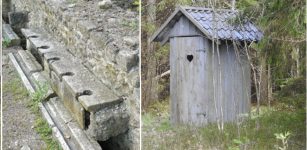 How Did People Go To The Toilet In The Past Before The Invention Of The Flush Toilet?
Archaeology | Jun 10, 2023
How Did People Go To The Toilet In The Past Before The Invention Of The Flush Toilet?
Archaeology | Jun 10, 2023 -
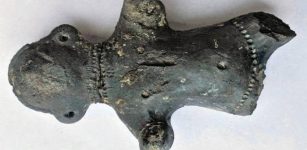 Evidence Of Sangam Age Settlement Unearthed At Nangur, Tamil Nadu
Archaeology | Jul 11, 2019
Evidence Of Sangam Age Settlement Unearthed At Nangur, Tamil Nadu
Archaeology | Jul 11, 2019 -
 Climate Change Behind Early Human Migration To The Americas At Key Intervals – Scientists Say
Archaeology | Feb 17, 2023
Climate Change Behind Early Human Migration To The Americas At Key Intervals – Scientists Say
Archaeology | Feb 17, 2023 -
 Unexpected Discovery – Medieval Monks Recorded Mysterious Volcanic Eruptions
News | Apr 6, 2023
Unexpected Discovery – Medieval Monks Recorded Mysterious Volcanic Eruptions
News | Apr 6, 2023 -
 Strange Ancient Underground Mystery In Connecticut Baffles Residents And Scientists
Featured Stories | Jun 3, 2024
Strange Ancient Underground Mystery In Connecticut Baffles Residents And Scientists
Featured Stories | Jun 3, 2024 -
 Ancient Secrets Of The Aranmula Kannadi Mirror That Reflects You As You Really Look
Artifacts | Sep 10, 2021
Ancient Secrets Of The Aranmula Kannadi Mirror That Reflects You As You Really Look
Artifacts | Sep 10, 2021 -
 12,000-Year-Old Burial Of Female Shaman Unearthed In Turkey
Archaeology | Jul 31, 2024
12,000-Year-Old Burial Of Female Shaman Unearthed In Turkey
Archaeology | Jul 31, 2024 -
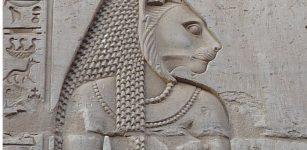 Fearsome Sekhmet: Lion-Headed Egyptian Goddess And Sister Of Ptah
Egyptian Mythology | May 13, 2020
Fearsome Sekhmet: Lion-Headed Egyptian Goddess And Sister Of Ptah
Egyptian Mythology | May 13, 2020 -
 One Of Europe’s Most Ancient Domestic Dogs Lived In The Basque Country 17,000 Years Ago
Archaeology | Nov 29, 2022
One Of Europe’s Most Ancient Domestic Dogs Lived In The Basque Country 17,000 Years Ago
Archaeology | Nov 29, 2022 -
 Shattering The Myth Of Men As Hunters And Women As Gatherers
Archaeology | Jun 29, 2023
Shattering The Myth Of Men As Hunters And Women As Gatherers
Archaeology | Jun 29, 2023 -
 Ancient DNA Reveals Origin Of First Bronze Age Civilizations In Europe
Archaeology | May 8, 2021
Ancient DNA Reveals Origin Of First Bronze Age Civilizations In Europe
Archaeology | May 8, 2021 -
 Unknown Ancient Structures Discovered At Machu Picchu By LIDAR
Archaeology | Mar 29, 2022
Unknown Ancient Structures Discovered At Machu Picchu By LIDAR
Archaeology | Mar 29, 2022 -
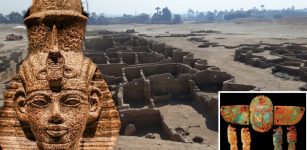 Lost Golden City Of Pharaoh Amenhotep III Discovered In Luxor
Archaeology | Apr 9, 2021
Lost Golden City Of Pharaoh Amenhotep III Discovered In Luxor
Archaeology | Apr 9, 2021 -
 Paranthropus Robustus Who Lived 2 Million Years Ago Walked Upright Like Modern Humans
Human Beginnings | Mar 7, 2025
Paranthropus Robustus Who Lived 2 Million Years Ago Walked Upright Like Modern Humans
Human Beginnings | Mar 7, 2025 -
 Yama – Hindu God Who Rules Over The Dead And Souls And Guards Akashic Records
Featured Stories | Sep 17, 2018
Yama – Hindu God Who Rules Over The Dead And Souls And Guards Akashic Records
Featured Stories | Sep 17, 2018 -
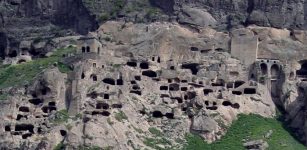 Uplistsikhe Devastated By Genghis-Khan Hordes But Once City-Fortress Of Queen Tamar
Featured Stories | Apr 12, 2021
Uplistsikhe Devastated By Genghis-Khan Hordes But Once City-Fortress Of Queen Tamar
Featured Stories | Apr 12, 2021 -
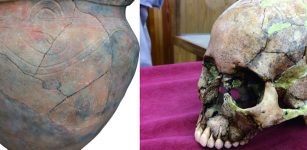 Ancient DNA Has Rewritten Early Japanese History
Archaeology | Sep 17, 2021
Ancient DNA Has Rewritten Early Japanese History
Archaeology | Sep 17, 2021 -
 Ancient Secrets Of Rare Maps Of Judah Ben Zara Revealed
Artifacts | Sep 20, 2022
Ancient Secrets Of Rare Maps Of Judah Ben Zara Revealed
Artifacts | Sep 20, 2022

